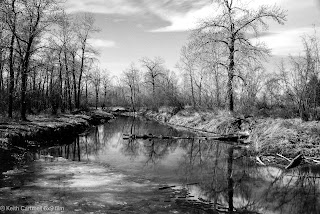Film photography, especially medium format, and even more especially large format, which I haven't got to yet and might never, is about mindfulness. Taking ones time with the composition. Making sure everything is right before clicking the shutter button. There are photographers that work through an actual checklist on their phone or taped to the back of the camera.
Let's just say it's a work in progress for me. So far about the only mistake I haven't made with the GW690 is leaving the lens cap on, mainly because I rarely have it on. Only to travel.
So there I was, out for a photo ramble with Sean, thinking we'd work on some long exposures in Carburn Park. The ponds are often really good for reflections. My thinking is that a reflection photo of something is more than twice as good as a photo of the thing by itself. Except the ponds are still mostly covered with ice. We were not deterred, and strolled around looking for compositions anyway. We even found some and ended up having a wonderful afternoon. Sometimes it's more about the people you might be with.
My thought was that I was going to expose black and white, and to that end I put on a yellow filter to increase contrast, along with a 10 stop ND filter for a bright sunny day with light clouds. The foil around the film roll said Lomo 100, which I knew. However I had forgotten they had come out of a box labeled color some time ago, and did not notice that it said Lomo colour 100 on the backing paper when I loaded it. Oops.
Most of these exposures are about 30 seconds, with the longest about 50 seconds. Even though the Viewfinder app gives exposure settings, and can compensate for ND filters up to 10 stops, it doesn't add in colour filters and doesn't calculate reciprocity failure. I think I read somewhere that a yellow filter is a third to half stop. I couldn't find any hard reciprocity data, the closest I could find is that some people treat it like an ISO 200 film. So I arbitrarily added some seconds to the exposure time. Other than the weird colour, the exposures seem to have come out well enough. I figure that between NLP and Lightroom, there's lots of latitude for fixing exposure, as long as you err on the over exposure side.
Running the negatives through Negative Lab Pro as colour was lurid and otherworldly to say the least. I was mostly doing reflections of trees in the water, and that lens is sharp sharp sharp. The sense of space and light was interesting, but a bit off putting. Nothing I could do in NLP or Lightroom could fix that. The solution is to drop out colour and convert the negative to black and white right from the start. I was more careful the second time with dust, and ended up with cleaner scans, so that much was to the good.
These are lightly edited in NLP and Lightroom. I'm thinking I really should get Nic Silver Efex. I'm coming to like black and white more and more.
1A.
I suppose I should note that I'm not trying to produce a print here. There's still some dust spots, and the shadows are a bit dark. I should probably do a better job of cleaning the various filters. With a bit of work I could probably increase the contrast in the sky, but doing that between the tree branches is tricky.
My plan is to give the ponds a couple weeks for the ice to clear and try again, this time taking out some of the Lomo 100 earl grey. I kind of like the look of the naked branches, so after ice and before leaves is perfect. Let me know if you live in Calgary and want to come along.













1B may be lurid, but with a bit of desaturation and a person or ghost on the bench, I think the idea has merit. Your numbers 8 and 10 (9th and 11th respectively) work the best for me and both for the same reasons. In both images there are shapes and implied lines that let me lazily wander through without falling out of the images. I always enjoy our walks. Cheers
ReplyDelete